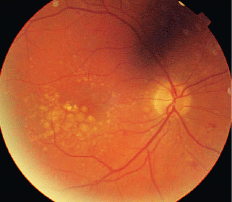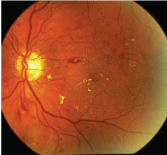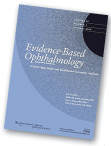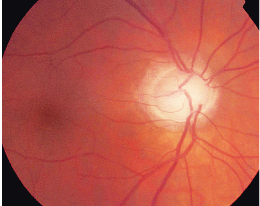In recent years, the concept of evidence-based medicine (EBM) has grabbed the attention of professionals, insurers, and even the average patient. The notion of EBM has found its way into mainstream media, and all disciplines rely on its principles when providing all levels of health care.1
In simple terms, EBM supposes that care of the highest quality is provided based on peer-reviewed information available to medical practitioners. The goal of EBM is to provide individual patients "with care based on the best evidence that is currently available."2,3
What is EBM?

This patient has large drusen and retinal hemorrhages due to age-related macular degeneration. Evidence-based
medicine has shown that preventive measures in such cases can help preserve vision.
Evidence-based health care originated in ancient medicine, but the development and evolution of the modern concept is attributed to David L. Sackett, M.D., and William Rosenberg, M.D., D.Phil.4 (See "Evolution of EBM," below.) Evidence-based medicine has been incorporated into many different facets of health care. Simply put, it is a mechanism for espousing best practices when caring for patients.
In their landmark article, Drs. Sackett and Rosenberg defined EBM as "the conscientious, explicit and judicious use of current best evidence in making decisions about the care of individual patients."4 Evidence-based medicine is not "cookbook medicine," they write. EBM takes a bottom up approach that combines "individual clinical expertise and the best available external evidence, and neither alone is enough."
EBM translates a clinical question to a searchable question, and then applies the outcomes-based information to daily patient care. This approach requires the practitioner to remain current with the literature and apply it as appropriate when caring for a specific patient.5,6 EBM promotes life-long learning and allows for judicious analysis of clinical findings where randomized clinical trials are the industry standard.
The Evolution of EBM
Evidence-based medicine had its genesis in both ancient Greek and Chinese medicine. In the early annals of medicine, metaphysicians and physicians put into practice every possible approach to treatment—blood letting, herbal or holistic therapies and, in the case of Eastern medicine, acupuncture.
As caring for the sick approached modern times, the practice of medicine evolved and, by the pre-antibiotic era during the first half of the 20th century, the philosophy was to do nothing but observe.
Then came the antibiotic era, and everything was treated—even if the treatment wasn't proven to be efficacious. The treatment philosophy: Now that we have antibiotics, let's use them and observe if they work or not.
Indiscriminate use of antibiotics has given way to a more judicious and selective approach to treatment, especially when it was determined that not all infections responded to treatment (i.e., viral infections) and, even worse, resistance developed with arbitrary use of anti-infective agents.
This is where searching the literature began to weave its way into a more guided approach to care. With the advent of the Internet and readily available information (sometimes just facts), it is not only a question of evaluation of the evidence, but also rigorous review of the quality of that evidence, that has become the standard.
How to Apply EBM

EBM informs us that patients who have diabetic retinopathy and diabetic macular edema should maintain strict glycemic control.
The practice of evidence-based medicine begins with the clinical challenge of relating the patient's signs and symptoms with your findings. Once the problem is defined, the next step is to comprehensively search the literature for the best evidence that relates to the problem. It might be challenging for the clinician if there are few studies pointing to the problem. Or worse yet, several studies may be available, but the number of subjects is not adequate to formulate an evidence-based opinion. Searching a textbook or the literature to find an article or a handful of citations will not provide the answer to management strategies for a specific patient.
However, the advent of the Internet and the proliferation of available clinical data and information provide us with an ever-increasing opportunity to acquire knowledge about specific topics. Among sources of information, journal articles are typically more current than textbooks and often report on a particular study. Also, articles can be accessed through online search engines. Online databases that search multiple articles and synthesize the literature to provide meta-analysis are most effective in obtaining evidence-based information for the clinician.
At the top of the pyramid of evidence-based medicine are the prospective, randomized clinical trials and the examination of data known as meta-analysis. (See "Converting Risk Into Treatment," below.) Additionally, widespread interest in the topic has given rise to journals devoted to the subject of outcomes-based clinical care. Peer-reviewed journals devoted to evidence-based medicine are available in a number of disciplines. Evidence-Based Ophthalmology is one such journal that has particular import for eye care professionals.

Armed with all this information, the clinician must then evaluate all of the available evidence, not only for relevance but also for quality. The final step in the process of EBM is to apply that evidence to a specific case, during the chairside examination or following review of laboratory or diagnostic testing data.1,7
EBM in Eye Care
A good example of the evidence-based approach in eye care is how we now manage patients who are at risk for vision loss from age-related macular degeneration by relying on data from the Age-Related Eye Disease Study (AREDS).9 AREDS clearly demonstrated the efficacy of antioxidant therapy for patients with moderate to advanced retinal changes associated with age-related macular degeneration. Conversely, the study also clearly demonstrated that there is no benefit to recommending treatment as a preventative measure for patients with mild or no signs of macular changes.
Converting Risk Into Treatment
We rely on randomized clinical trials to help assign a relative risk reduction (RRR) for a given treatment modality. RRR is a way to describe (i.e., overinflate) the relative impact of a treatment on an outcome.8
Other studies, either recently reported or nearing completion, have focused on the alternate therapy of anti-angiogenic agents, such as Avastin (bevacizumab, Genentech), Lucentis (ranibizumab, Genentech) and Macugen (pegaptanib sodium, Eyetech/Pfizer), among others. Such studies as ANCHOR (Anti-VEGF Antibody for the Treatment of Predominantly Classic Choroidal Neovascularization in AMD) and CATT (Comparison of Age-Related Macular Degeneration Treatments Trials: Lucentis-Avastin Trial, currently ongoing) are recent examples of evidence-based studies looking at the benefit of treating choroidal neovascular lesions of macular disease.10,11
However, relative risk reduction may overinflate the value of a particular intervention, so absolute risk reduction (ARR) is often a better indicator. The difference between relative risk reduction and absolute risk reduction is the number of patients needed to treat (NNT) in order to prevent one event. Prophylactic treatment may be indicated if the NNT is high.8
Probably nowhere in eye care has evidence-based medicine been practiced more than in the realm of managing diabetic retinopathy. Numerous studies with meta-analyses have been conducted over the last four decades relating to the benefit of maintaining optimal glycemic control for preventing microvascular complications of diabetes. Examples include the Diabetes Control and Complications Trial (DCCT) and the United Kingdom Prospective Diabetes Study (UKPDS).12,13
Subsequent studies have reinforced the clinical practices that were derived from these initial outcomes-based clinical trials. More importantly, evidence-based studies indicating best practices for reducing the risk of severe vision loss from diabetic retinopathy--including the Diabetic Retinopathy Study (DRS) and the Early Treatment Diabetic Retinopathy Study (ETDRS)--have provided important clinical guidance when managing patients with diabetes.14-16 (See "Evidence-Based Strategies to Reduce Complications of Diabetes Mellitus," below.)

A glaucomatous optic nerve likely calls for IOP-lowering medication. But when the risk of disease conversion is not so clear, EBM is being used to guide glaucoma management.
The
The emergence of EBM has awakened a movement toward more in-depth analysis and vetting of data purported to be scientific. We now have entered the era of meta-analysis, risk calculators and the Cochrane Collaboration.
Meta-analysis. This is a statistical technique for amalgamating, summarizing and reviewing previous quantitative research. A wide variety of questions can be investigated, as long as a reasonable body of primary research studies exists. For example, a study with few participants has limited value in meta-analysis. Meta-analysis changes the focus to direction and magnitude across different studies. By applying selected parts of reported results of primary studies and entering it into a database, this "meta-data" is "meta-analyzed."
Risk calculators. These have become more popular in recent years. Sometimes developed as a marketing tool by industry, the algorithms are generic and provide the clinician with guidance in managing chronic diseases. One such example of a commonly used system is the Glaucoma Risk Calculator (
http://ohts.wustl.edu/risk/calculator.html). The GRC was developed by taking findings from the Ocular Hypertension Study (OHTS) and validating its use in clinical practice in patients taking part in the Diagnostic Innovations in Glaucoma Study (DIGS). Risk calculators currently exist for a number of medical conditions including cardiovascular disease, autoimmune heart disease, lung cancer and obesity.
Cochrane Collaboration. This is a large, international collection of volunteers who use a systematic approach to evaluate the efficacy and safety of medical interventions. Since there is an increasing volume of evidence available to address clinical problems, EBM might be looked at as a mechanism for sorting out contradictions and data disparities.
This is particularly true when the Cochrane Collaboration evaluates an intervention, for example, and some of this evidence yields seemingly contradictory information or information that runs counter to a previous clinical standard.
Evidence-Based Strategies to Reduce Complications of Diabetes Mellitus
Factor
HDL-cholesterol
Triglycerides
ACE-1 inhibitor or ARB
Beta-blocker
This table summarizes the evidence-based outcomes derived from more than three decades of rigorous prospective clinical trials involving thousands of patients that provide best practices in overall management of a patient with diabetes.12-16
Recommended Level
HbA1c
7.0%
<100mg/dl
>40mg/dl
<150mg/dl
<130mm Hg
<80mm Hg
indicated for renal function
indicated for coronary artery disease
Conflicting Conclusions
An example is offered by the often-studied preferred practice for treating diabetic macular edema. Over the years, there have been studies too numerous to name aimed at identifying or re-establishing the best treatment modality for diabetic macular edema. An example of a Cochrane Analysis is an intervention review of whether to treat diabetic macular edema, and if so, which is the best method.
More recently, the National Eye Institutes
The Cochrane Analysis for diabetic macular edema takes a comprehensive look at a body of evidence that exists in the literature for treatment and management of the most common cause for decreased vision in diabetic persons.17 The methodology requires that collaborating volunteers undertake a meta-analysis of the question at hand, namely chronic diabetic macular edema, by combining the results of several studies that address either the clinical or research question.
In this analysis, conducted in June 2007, Cochrane volunteers searched databases for randomized clinical trials that evaluated any form of intravitreal steroids for treating DME. They found seven studies, involving 632 eyes with DME. Their conclusion: Randomized clinical trials suggest that steroids placed inside the eye by either intravitreal injection or surgical implantation may improve visual outcomes in eyes with persistent or refractory DME.
This report clarifies one approach to DME treatment. To further illustrate the value of evidence-based medicine, the DRCR has since published a prospective study comparing conventional laser treatment for diabetic macular edema with intravitreal triamcinalone injection.18 In this study, almost 700 patients with DME were evaluated at 88 sites. Patients were randomized into a steroid injection group or a conventional laser group, with the outcome being loss of 10 letters on the ETDRS chart. Early on, it appeared that visual acuity was better among subjects in the corticosteroid group. But by the end of the study, the traditional laser group had better vision and fewer complications compared to the steroid group.
As evidence-based medicine becomes increasingly important in providing clinical guidance--especially as it relates to vision-threatening retinal disease--support of prospective randomized trials is likewise increasingly necessary. EBM should guide postgraduate and continuing education, and should be a mechanism for promoting life-long learning.
At the same time, health care economic analysis, pay-for-performance and utilization review are beginning to rely on evidence-based medicine. During the next few years, we will likely witness a shift in health care reimbursement policies that rely almost entirely on evidence-based information.
Finally, EBM is a process and should not be taken out of the context of the random clinical trials that provide the clinician with the information that establishes the framework for best practices in patient care.
Dr. Cavallerano is currently an attending staff optometrist at the VA Boston Health Care System and the Director of the VA Care Coordination Store and
1. Gorman C. Are doctors just playing hunches? Time. 2007 Feb 15. Available at:
www.time.com/time/magazine/article/0,9171,1590448,00.html (accessed July 13, 2009).
2. Oxman AD, Sackett DL, Guyatt GH. Users guides to the medical literature. I. How to get started. The Evidence-Based Medicine Working Group. JAMA. 1993 Nov 3;270(17): 2093-5.
3. Oxman AD, Cook DJ, Guyatt GH. Users guides to the medical literature. VI. How to use an overview. Evidence-Based Medicine Working Group. JAMA. 1994 Nov 2;272(17): 1367-71.
4. Sackett DL, Rosenberg WM, Gray JA, et al. Evidence based medicine: what it is and what it isnt. BMJ. 1996 Jan 13;312(7023):71-2.
5. Rosenberg W, Donald A. Evidence-based medicine: An approach to clinical problem solving. BMJ. 1995 Apr 29;310(6987):1122-6.
6. Sackett DL, Haynes RB, Guyatt GH, et al. Clinical Epidemiology: A Basic Science for Clinical Medicine. 2nd ed.
7. Beltran DJ. Why is evidence-based medicine the legal standard of practice? Medscape J Med. 2008 Jan 21;10:21. Available at:
www.medscape.com/viewarticle/569067 (accessed February 28, 2008).
8.
9. Age-Related Eye Disease Study Research Group. A randomized, placebo-controlled, clinical trial of high-dose supplementation with vitamins C and E, beta carotene, and zinc for age-related macular degeneration and vision loss: AREDS report no. 8. Arch Ophthalmol. 2001 Oct;119(10):1417-36.
10. Kaiser PK, Brown DM, Zhang K, et al. Ranibizumab for predominantly classic neovascular age-related macular degeneration: subgroup analysis of first-year ANCHOR results. Am J Ophthalmol. 2007 Dec;144(6):850-857.
11. National Eye Institute. Comparison of AMD Treatments Trials (CATT): LucentisAvastin Trial. Available at:
www.nei.nih.gov/CATT/ (accessed July 13, 2009).
12. The Diabetes Control and Complications Trial Research Group. The effect of intensive treatment of diabetes on the development and progression of long-term complications in insulin-dependent diabetes mellitus. N Engl J Med. 1993 Sep 30;329(14):977-86.
13.
14. The Diabetic Retinopathy Study Research Group. Photocoagulation treatment of proliferative diabetic retinopathy: the second report of diabetic retinopathy study findings. Ophthalmology. 1978 Jan;85(1):82-106.
15. Early Treatment Diabetic Retinopathy Study Research Group. Photocoagulation for diabetic macular edema: Early Treatment Diabetic Retinopathy Study report number 1. Arch Ophthalmol. 1985 Dec;103(12):1796-806.
16. The Early Treatment Diabetic Retinopathy Study Research Group. Techniques for scatter and local photocoagulation treatment of diabetic retinopathy: Early Treatment Diabetic Retinopathy Study Report no. 3. Int Ophthalmol Clin. 1987 Winter;27(4):254-64.
17. Grover D, Li TJ, Chong CC. Cochrane Database Syst Rev. 2008 Jan 23;(1):CD005656.
18. Diabetic Retinopathy Clinical Research Network (DRCR.net), Beck RW, Edwards AR, Aiello LP, et al. Three-year follow-up of a randomized trial comparing focal/grid photocoagulation and intravitreal triamcinolone for diabetic macular edema. Arch Ophthalmol. 2009 Mar;127(3):245-51.

